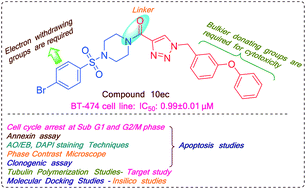Design and synthesis of substituted (1-(benzyl)-1H-1,2,3-triazol-4-yl)(piperazin-1-yl)methanone conjugates: study on their apoptosis inducing ability and tubulin polymerization inhibition†
Abstract
A library of substituted (1-(benzyl)-1H-1,2,3-triazol-4-yl)(piperazin-1-yl)methanone derivatives were designed, synthesized and screened for their in vitro cytotoxic activity against BT-474, HeLa, MCF-7, NCI-H460 and HaCaT cells by employing 3-(4,5-dimethylthiazol-2-yl)-2,5-diphenyltetrazolium bromide (MTT) assay. Among all the synthesized analogues, compound 10ec displayed the highest cytotoxicity with the IC50 value of 0.99 ± 0.01 μM towards BT-474 cancer cell line. The target compound (10ec) was also evaluated for its tubulin polymerization inhibition study. Detailed biological studies such as acridine orange/ethidium bromide (AO/EB), DAPI and annexin V-FITC/propidium iodide staining assay suggested that compound 10ec induced the apoptosis of BT-474 cells. The clonogenic assay revealed that the inhibition of colony formation in BT-474 cells by 10ec in concentration-dependent manner. Moreover, the flow cytometric analysis revealed that 10ec induced apoptosis via cell cycle arrest at the sub-G1 and G2/M phase. In silico studies of sulfonyl piperazine-integrated triazole conjugates unveil that they possess drug-like properties. According to the molecular modelling studies, compound 10ec binds to the colchicine binding site of the tubulin.



 Please wait while we load your content...
Please wait while we load your content...